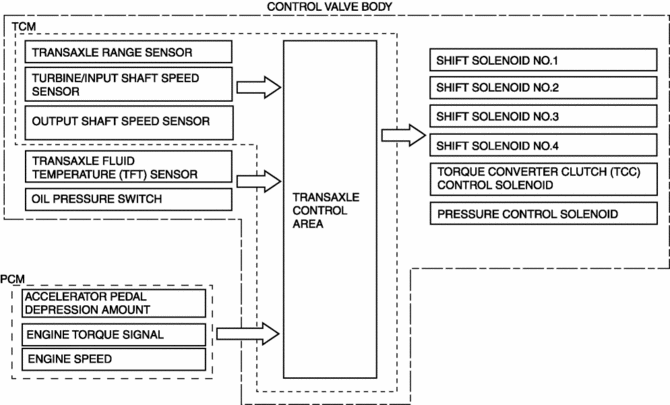Mazda CX-5 Service & Repair Manual: Shift Pressure Control (Direct Electric Shift Control) [Fw6 A EL, Fw6 Ax EL]
Outline
-
The TCM drives shift solenoids No.1, 2, 3, 4, the pressure control solenoid, and the on/off solenoid based on inputs signals from each switch and sensor, and performs direct electronic control of the clutch engagement pressure. As a result, precise hydraulic pressure control of the clutch engagement, not possible using a conventional accumulator, is achieved.
Construction

Operation
N to D, and N to R selected
-
When N to D, and N to R are selected, the TCM drives the pressure control solenoid and shift solenoids No. 1 and 3 for optimum clutch engagement pressure control.
Shifting
-
During shifting, the TCM drives shift solenoids No.1, 2, 3, and 4 to directly control the clutch engagement pressure for optimum clutch engagement pressure control.
-
During each gear shift, the engagement side clutch pressure and release side clutch pressure are controlled simultaneously. As a result, the torque capacities of both clutches can be controlled in connection to each other when switching clutches, engine over-speed during shifting and interlock among clutches is prevented, and smooth and responsive shifting is achieved.
 Shift Lock System [Fw6 A EL, Fw6 Ax EL]
Shift Lock System [Fw6 A EL, Fw6 Ax EL]
Purpose, Function
The shift-lock system operates when the ignition is switched to ON and the
brake pedal is not depressed, and inhibits the selector lever from being shifted
from the P po ...
 Shift Pressure Control (Learning Control) [Fw6 A EL, Fw6 Ax EL]
Shift Pressure Control (Learning Control) [Fw6 A EL, Fw6 Ax EL]
Outline
The TCM optimizes the hydraulic pressure for clutch engagement and disengagement
through learning correction of the clutch engagement pressure.
NOTE:
The clutch engagem ...
Other materials:
Positive Crankcase Ventilation (PCV) Valve Inspection
Airflow Inspection
1. Disconnect the section (A) of ventilation hose shown in the figure.
2. Start the engine and verify that vacuum is applied to the end of the disconnected
ventilation hose while the engine is idling.
If vacuum is not applied to the ventilation hose, perform the p ...
Manifold Absolute Pressure (Map) Sensor
Purpose/Function
Detects the intake air pressure introduced into the cylinder as basic information
for mainly determining the fuel injection amount.
Detects the intake air pressure introduced into the cylinder and inputs it
to the PCM as an intake air pressure signal.
Cons ...
Audio Control Switch Operation
When the audio unit is turned on, operation of the audio unit from the steering
wheel is possible.
NOTE
Because the audio unit will be turned off under the following conditions,
the switches will be inoperable.
• When the ignition is switched off.
• When the power button on the audio uni ...
